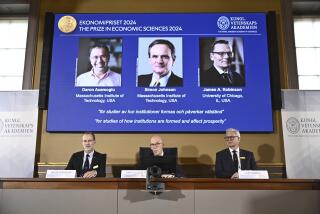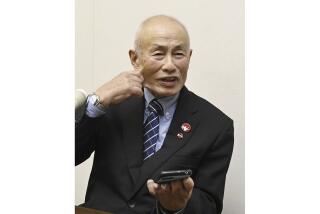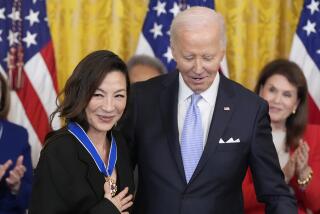Nobel Prize Sets Off a Land Mine
WASHINGTON — It’s hard to imagine how the Nobel Peace Prize could bring so much grief.
Nearly four months after winning the 1997 prize, the global campaign to rid the world of land mines is still reeling from the impact, torn by ego clashes and disagreements, including a fight over control of the award money.
According to those involved, the accumulation of troubles threaten to slow momentum on a number of fronts, including winning ratification of the movement’s crowning achievement: a global treaty banning anti-personnel land mines signed by 122 nations last December in Ottawa.
The disputes have also raised concern about the ability of the 1,000-member International Campaign to Ban Landmines to capitalize--as other winners have--on the enormous lobbying and fund-raising boosts that often are among the prize’s most important benefits.
The Nobel was awarded jointly to the campaign and its coordinator, Jody Williams, a 47-year-old political activist from Vermont. Singling her out for recognition instantly heightened long-simmering differences within the movement, drawing applause from some quarters and consternation from others.
Many interviewed for this article believe the contributions of at least half a dozen individuals have been so crucial to the land-mine cause that it was wrong--and potentially destructive--to honor one person.
Williams said internal differences had existed over a long period, but she admitted they were exacerbated by the prize.
“We’re talking about lots of people with strong personalities and egos,” she said. “Sometimes the campaign has been held together because of these personalities and sometimes in spite of them. But there’s no doubt that the Nobel ratcheted up these tensions.”
Someone who knows many of the players well, but who declined to be identified, had a more blunt view of the prize: “It was the last straw.”
Indeed, the story of the 1997 Nobel is, in many ways, merely a reminder of how divisive fame and money can be.
Among the developments since the prize was awarded Dec. 10:
* Williams has severed ties with the leading U.S.-based group in the campaign, the Vietnam Veterans of America Foundation. The foundation launched the land mine effort seven years ago, hired Williams to coordinate it and paid her salary, which was more than $60,000 when she left. All agree their differences were irreconcilable.
Williams, who is entitled to half of the $1-million award money, has said she has not decided how she will use her share--a stance that has raised hackles within the campaign among those who assumed the entire monetary award would go to the movement.
She also said she plans to step away from day-to-day coordination of the international campaign but will remain involved by using her Nobel laureate status to lobby governments to support the treaty.
* Williams and veterans’ foundation President Bobby Muller, arguably the movement’s two most prominent figures, said they have not spoken since the Nobel ceremony in Oslo. In separate interviews, neither gave any indication he or she plans to change that.
* Muller has hinted strongly he plans to end the foundation’s role as a major player in the campaign and instead concentrate efforts domestically to get the U.S. government to sign the new treaty banning land mines.
“It’s not my expectation that the ICBL will . . . warrant further investment of our resources,” Muller said in an interview. But, he said, “we’ll keep a seat at the table, if nothing else, just to keep track of what’s going on.”
Such a development would rob the movement of one of its two co-founding organizations and its largest single financial backer.
Another of the most active groups, the Swedish arm of Save the Children, has also decided to scale back its involvement, although its communications director, Carl von Essen, said the move was prompted by a shift in priorities, not differences with the campaign.
* Leading members of the roughly 1,000 nongovernmental organizations worldwide that make up the movement are battling over control of the campaign’s $500,000 share of the prize money.
Campaign’s Share Held by Nobel Panel
So far, sources linked to the movement cite at least two offers that were made to place the Nobel funds in trust pending a decision on how to use them, but they said the offers were rejected by members of the campaign’s 12-member steering committee. Representatives of many of the largest affiliated groups are scheduled to meet next month in Germany, in part to resolve the issue.
Until they do, the Nobel Committee in Oslo says it is holding on to the campaign’s share. It marks the first time the Nobel has had to keep prize money since 1991, when Burmese dissident Aung San Suu Kyi won while under house arrest.
Anti-personnel land mines are small explosive devices scattered by the millions across the landscapes of Asia, Africa and Europe during brief periods of conflict to hamper the movement of enemy forces. They lie dormant--and dangerous--for years afterward.
Critics estimate the weapons claim about 26,000 lives annually, mainly farmers or other innocents unlucky enough to stumble across one.
On the advice of the Pentagon, which is fearful of giving up a weapon it says can protect its soldiers, the United States has refused to sign the Ottawa treaty, which is an international convention banning the production, stockpiling and use of anti-personnel land mines.
While Williams downplays any harm the Nobel brought to the campaign, Muller painted a darker picture, saying the prize nearly tore the coalition apart during the weeks between the Oct. 10 announcement and the award ceremony in December, a period that included the signing of the international treaty.
“It was hard to keep this thing together and get through Ottawa and Oslo without there being a public disintegration of the campaign,” Muller said. “The fissures that were there just got magnified because of the pressures the Nobel prize put on us. The real challenge of the past weeks has been to keep smiling.”
Muller said he was especially disillusioned by the fight over who should receive and hold the campaign’s share of the prize money.
“There were never any fights over money before because we didn’t have any,” he said. “You put half a million dollars and a reputation on the table and everyone goes nuts.”
Added a disillusioned official close to the movement: “It’s been a very upsetting, revealing experience. It was clear they [the Nobel Committee] had no clue about the roles and the egos within the coalition and that singling out one individual was unwise. There’s no question Jody Williams did invaluable work, but so did a lot of others.”
Humanizing Element Cited
Arne Westad, chairman of the Nobel Prize Research Committee in Oslo, said the committee believed naming an individual together with a cause had certain merits. “I do think in many cases, people like to have a human face to connect to,” he said.
In 1995, for example, the prize went jointly to the British peace advocacy group, Pugwash Conference on Science and World Affairs, and its founder, Joseph Rotblat. But unlike the Pugwash award, for which Rotblat was the easily identifiable founding and driving force, the land mine coalition had at least a half a dozen key figures who played different yet vital roles in pushing the issue forward.
“Without Jody or [Canadian Foreign Minister Lloyd] Axworthy, there would have been no treaty, but without Bobby [Muller] or [Sen. Patrick J.] Leahy [D-Vt.], there would have been no campaign in the first place,” said a source who knows the movement well but who declined to be identified.
Leahy formally nominated the campaign and Axworthy for the prize, although he also supported the joint nomination of the campaign and Williams, who is a resident of Leahy’s home state.
The senator wrote and won passage of the first legislation banning the export of land mines in 1992 and has been extremely active on the issue in the years since. Axworthy was instrumental in getting governments to back the treaty.
Others, including Thomas Gebauer, director of the German relief organization Medico International, which co-founded the campaign in 1991 with Muller’s VVAF, were also mentioned as worthy potential recipients.
Some sources within the campaign believe Williams was singled out because she lobbied personally for the prize. It is an accusation she denies.
“Even if I had, it wouldn’t have mattered . . . ,” she said.
Certainly lobbying has become an element in the Nobel selection process. Nobel committee officials say they rely mainly on an extensive in-house library and a string of outside consultants to research and report on the work of serious candidates but that personal promotion has definitely become a part of the ritual.
Committee Secretary Guy Lundestad said that about 10 of the 129 candidates nominated last year--including Williams and a colleague in the land mine coalition--made personal visits to the Nobel Institute in Oslo.
“A Norwegian member of the [land mine] campaign asked for the meeting, and I gave them 30 to 40 minutes,” he said.
Lundestad said organized write-in campaigns in favor of specific candidates have also become popular, although he says they make little impression.
“The record is 750,000 signatures,” he said, declining to identify the nominee involved. “We either destroy them or send them back.”
Although those interviewed believe personality clashes have caused much of the trouble, substantive disagreements also exist. For example, Muller and Williams are split over the importance of bringing the United States into the treaty and how to go about doing it.
Muller, a former Marine lieutenant and Vietnam veteran, sees U.S. participation as crucial and has worked carefully to win support for the ban both at the Pentagon and from a president wary of countering the advice of his military. He is convinced Williams’ initial comments immediately after winning the prize seriously damaged his efforts.
Those comments from Williams--who says an American signature on the Ottawa treaty would be nice but not vital--included characterizing Clinton as “a weenie.”
“Part of what a Nobel does is to give an issue a spokesperson and a microphone, and quite frankly, what Jody did with it was terribly counterproductive for us in our work to try to get the U.S. connected to the treaty,” Muller said.
Williams said her characterization of the president was an off-the-record comment exploited by reporters. “And besides, he’s been called worse than that by people he considers his friends.”
This is not the first time a Nobel Peace Prize has come between crusaders of a humanitarian cause.
Within months of winning the 1976 prize, Northern Ireland peace activists Betty Williams and Mairead Corrigan fell out over the division of the award money in a dispute that eventually discredited them both and killed their movement. More than 10 years later, the two still refused to speak to each other during filming of a documentary about the movement they founded.
“It’s clear the prize does work in different directions,” Westad said.
Some campaign members and outside sympathizers are dismayed that a movement that had toiled so hard for so long in relative obscurity now seems in danger of losing its way, or, at the very least, of squandering the incalculable momentum, prestige and legitimacy a Nobel Peace Prize can bring.
“The prize gave the signing ceremony [in Ottawa] a real profile, but they let it go by,” said a source familiar with the campaign’s inner workings who declined to be identified by name or organization.
“Could they have used it to bring more governments on board if they hadn’t been distracted by fights over who should be allowed on the podium in Oslo? I don’t know, but it didn’t help,” the source said.
Williams vehemently rejected such criticism, arguing that about 20 additional countries, including Japan, were persuaded to sign the treaty during the few weeks that separated the Nobel announcement and Ottawa. The treaty takes effect once ratified by 40 nations, and Williams said the goal is to get the 40th signature within the year.
“Our momentum is rolling right along,” she said.
Others expressed concern that the campaign has so far done little to capitalize on the Nobel as a vehicle for raising funds that could eventually dwarf the prize money itself.
Aryeh Neier, president of the international philanthropic group Soros Foundation, said he watched London-based Amnesty International skillfully and quickly exploit its 1977 Nobel Prize into a fund-raising windfall. He characterized the land mine campaign as slow by comparison.
“I’m not at all ready to give up on them, because it’s still relatively early, but they need to get moving,” Neier said. “If they get their act together in February, they can still accomplish something significant.”
Through the Open Society Institute, Soros funds a $3.9-million program to increase public awareness of the land mines issue.
The 1985 winner, the International Physicians for the Prevention of Nuclear War Inc., also quickly capitalized on the Nobel, according to those involved. “They managed to turn it into a pretty powerful fund-raising mechanism in the years afterwards and built a direct-mail base that sustains them to this day,” said Charles Clements, president of Physicians for Human Rights, who worked closely with the Pugwash group.
Despite the problems it has brought, neither Williams, Muller nor anyone else interviewed, said he would wish away the Nobel.
“Even with the difficulties and the hard feelings, there’s no doubt that the overall lift for the issue has been great,” Muller said. “The public has become extraordinarily aware of the land mines issue.”
More to Read
Sign up for Essential California
The most important California stories and recommendations in your inbox every morning.
You may occasionally receive promotional content from the Los Angeles Times.










